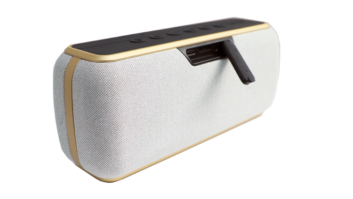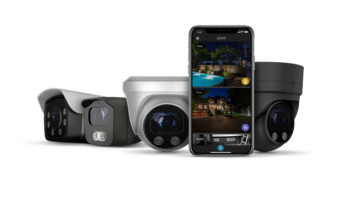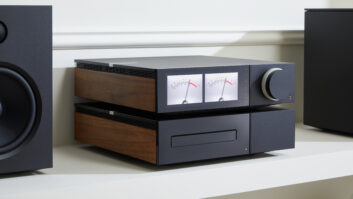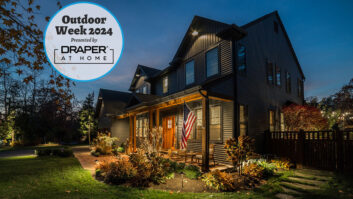One of the most coveted views in New York is the one that overlooks Central Park. The ability to see the lush leaves (in summer) and the climbing branches (in winter) of the near forest that sits in the heart of the city accounts for the staggering real estate prices that distinguish the buildings on the perimeter of this quintessential New York landmark.

In keeping with the clean lines and tastefully minimalistic decor of this Trump Tower duplex, Split Rock management team leaders, Edward Cruz and Kathleen Comerford (left and right, respectively), chose to install 32 Onsia Speakers for their cloak of invisibility. What isn’t invisible is that fabulous Central Park view
Among these luxurious residences is the iconic 68-story Trump Tower where the real estate development firm, Split Rock Associates, and a group of investors purchased a $15 million multi-level condo on the 48th floor and set about renovating its three contiguous units. Determined to bring “first time” scenarios to the already sophisticated space, Split Rock management team leaders, Edward Cruz and Kathleen Comerford, turned to Colorado vNet to integrate a whole-house technology system kitted out with controls for lighting, climate, draperies, audio, cameras, and much more.
INITIAL CONSIDERATIONS
Purchased by the Split Rock team in 2007, the 3,400-square-foot residence was treated to nine months of approvals before nary a touchscreen or speaker cable could be installed. With the goahead finally in hand, Cruz and company started renovations on the unit in the summer of 2008, already intending to use Colorado vNet (see sidebar) as the core of the apartment’s technology design.
“We like the simplicity of the installation,” said Cruz, who once worked as an electrical engineer in Florida. “The components and devices are sleek and sexy, but their functionality is what makes them superior in many ways. So does the price point; I can buy a touchscreen for every room and not have to worry about buying an amplifier module for six zones that would cost me another $35,000 or $45,000.”

Wanting to pre-empt a visit from the concierge, Cruz and his team carefully considered their soundproofing options before settling on QuietBat and Quiet Barrier MD sound-deadening rubber by Sound Proof Foam to keep the noise levels strictly within the confines of the apartment.
Unlike other units in the posh digs, Cruz’s apartment is rigged with 14 Vibe Touchscreen Amplifiers, as well as 24 customizable Colorado vNet Touchpads that provide pre-programmed lighting and control scenes. The home’s music is stored on an audio server that is accessible via Vibe touchscreens, while an Apple iPod can be docked to several stations around the home for multi-zone audio distribution, enabling guests to experience their music as the homeowner would.
Cognizant of the limited closet space available to most New Yorkers, Cruz noted that the Vibe system saved him from having to allocate precious space for an equipment room. Each touchscreen has a built-in 75-watt amplifier, and the wall-recessed panels and touch keys all have fans and cooling systems that eliminate the need for a dedicated rack-system closet.
“I believe when it comes to designing a home you shouldn’t have to worry about where you are going to put that equipment room,” he explained. A lot of people say the sound isn’t as loud as it could be, as what you can get out of some of these other systems, but right out of the back of the touchscreen there are audio lines out, which you can make either variable or fixed, and send that out of the wall into an amplifier or subwoofer and really kick up the sound.”
In addition to music and home theater control, the Vibe system’s touchscreens are also the nerve center for climate control and the camera systems dispersed throughout the duplex. Home heating and cooling can be adjusted from the master suite, for example, without having to climb upstairs to set the temperature in other rooms. Similarly, the security and camera equipment has been integrated into the Vibe touchscreens, providing easy monitoring of the entire apartment from any location where a screen is installed.
DON’T DISTURB THE NEIGHBORS
Being housed on the 48th and 49th floors in a much-sought-after Manhattan high-rise comes with a host of challenges, especially when 32 speakers have been discreetly tucked into the walls. Wanting to pre-empt a visit from the concierge, Cruz and his team carefully considered their soundproofing options before settling on QuietBat and Quiet Barrier MD sound-deadening rubber by Sound Proof Foam to keep the noise levels strictly within the confines of the apartment.
“The Quietbat, when it’s applied on both sides with the acoustical batting in the middle, has the sound-deadening effect nine times greater than that of one single sheet of dry wall,” Cruz said. “When you talk about sound deadening, this apartment is extremely quiet. You can’t hear anything in here. Every wall in the space has Quietbat. That is equivalent to $65 a sheet as opposed to $12 a sheet. It was a significant cost addition to the project, but that helped us achieve the goal of making it a quiet space. If we were to turn up the system we can hit high levels before you hear the bump, bump, bump, on the ceiling.”
The walls weren’t the only precaution the team took to keep the neighbors happy. The installation crew also lined the floorboards with Sika Corp’s AcouBond System, a specially slotted foam mat that adheres to wood flooring, effectively investing the slots with sound-dampening powers.

In addition to music and home theater control, the Colorado vNet Vibe system’s touchscreens are also the nerve center for climate control and the camera systems dispersed throughout the duplex.
“The beauty behind it is that it also allows for heat transfer,” Cruz noted, “so if you wanted to put heating in, which we did, it allows that to transfer up through the wood material while it is still glued down and bonded.”
OUT OF SIGHT, NOT EARSHOT
In keeping with the clean lines and tastefully minimalistic decor of the duplex, Cruz chose to install 32 Onsia Speakers for their cloak of invisibility. As is the case with many of the invisible speaker lines currently on the market, Onsia’s range utilizes the principle of a vibrating soundboard to distribute sound in a surrounding environment without cracking the plaster.
“This is a line array, linear diffuser type speaker system,” said Cruz, who integrated seven of Onsia’s in-wall and five of its in-ceiling along one subwoofer, into the apartment’s home theater. “You actually bury them into the plaster and dry wall, then you give them a coat of plaster. They tune themselves and harmonically match the frequency of the drywall; the dry wall in essence becomes the speaker, so there is no visible speaker.”
THE INTEGRATOR AS BEST CUSTOMER
The Trump Tower duplex, which took 14 months to completely renovate, is now on the market. Cruz, who has acted as both integrator and customer during the installation process, is more than pleased with the end result.
“Typically we are the user, we are the client,” he noted. “I designed the whole thing, including what switches were going to do what. The hardest part of programming, without asking the customer a million questions, is to be able to say, ‘You know what, when I go into the bathroom during the day I want the lights to ramp up in maybe one second, but at night I want that to take three seconds.’ Little things like that, such as lighting scenes, are the benefits of doing it for ourselves.”







